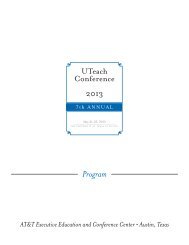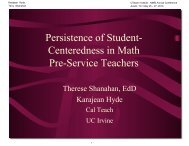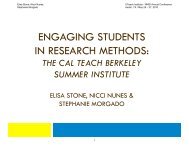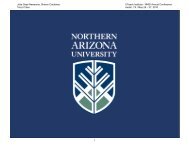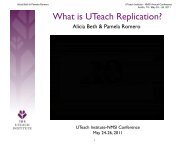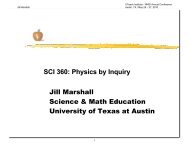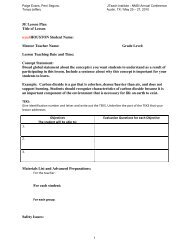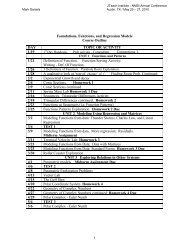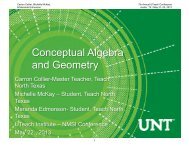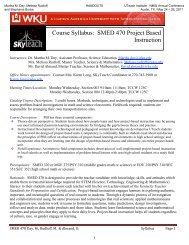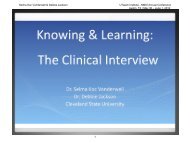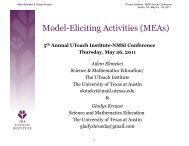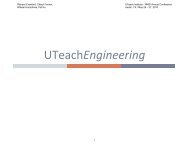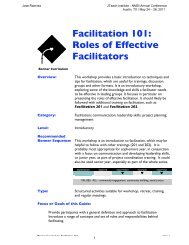Pinhole Camera Design Challenge Instructor Notes. Jill Marshall ...
Pinhole Camera Design Challenge Instructor Notes. Jill Marshall ...
Pinhole Camera Design Challenge Instructor Notes. Jill Marshall ...
You also want an ePaper? Increase the reach of your titles
YUMPU automatically turns print PDFs into web optimized ePapers that Google loves.
<strong>Jill</strong> <strong>Marshall</strong> &<br />
Gretchen Edelmon<br />
Handout - 1<br />
<strong>Design</strong> <strong>Challenge</strong> <strong>Instructor</strong> <strong>Notes</strong><br />
UTeach Institute - NMSI Annual Conference<br />
Austin, TX / May 24 – 26, 2011<br />
<strong>Pinhole</strong> <strong>Camera</strong> <strong>Design</strong> <strong>Challenge</strong> <strong>Instructor</strong> <strong>Notes</strong>. <br />
<strong>Jill</strong> <strong>Marshall</strong>, Gretchen Edelmon, Adaptation suggested by Carter Tiernan <br />
Note: Please send suggested corrections/revisions to marshall@mail.utexas.edu <br />
especially if you have used or will use the activity in class.) <br />
Summary: The pinhole camera design challenge is designed to be carried out during 1‐2 <br />
class periods in Classroom Interactions with the goals of: <br />
• Demonstrating an interdisciplinary STEM learning opportunity <br />
• Developing student awareness of design process (engineering practice) <br />
• Encouraging consideration of lesson planning as a design activity <br />
• Creating a finished product with authentic use to teachers <br />
• Engaging students <br />
Students are expected to work in groups of 2‐3 based on expected teaching content areas, <br />
i.e., future math teachers together, future biology teachers together, etc.. The goal is for <br />
each team to design a pinhole camera for use in their own future classrooms from <br />
affordable materials. Students are expecting to (1) describe a lesson in which the camera <br />
will be used, (2) document needs and specifications, (3) create a plan including a scale <br />
drawing and materials list, (4) build and document a prototype, (5) test the prototype on <br />
randomly selected classmates, documenting the results of the test, (6) document a plan for <br />
revisions and (7) submit the documentation of the entire project for review. The class will <br />
reflect on the design process, propose steps for the design procedure, and compare the <br />
steps with the UTeachEngineering design process. <br />
Suggested Materials (per team) <br />
‐ 1 roll black electrical tape, 1 roll transparent tape <br />
‐ Black construction paper <br />
‐ White construction paper or card stock <br />
‐ Pair of scissors <br />
‐ I paper towel roll <br />
‐ 2 sheets of velum paper <br />
‐ Poster sticky adhesive <br />
‐ meter stick and small ruler <br />
‐ gridded paper/engineering pad <br />
‐ calculators <br />
‐ various boxes/containers (e.g., shoe boxes, oatmeal canisters, cereal boxes, soft <br />
drink cartons, standard cardboard shipping boxes, etc.) <br />
Teacher will also need needles, hole punch, compasses etc., to make pinholes, for the <br />
entire class, as well as images to project if there is no access to windows. <br />
Suggested schedule for implementation in Classroom Interactions <br />
Divide into teaching area groups. <br />
Preview day <br />
5 min: Think/pair/share or quick write: What is the difference between science and <br />
engineering? OR How is what engineers do different from what scientists do? OR What <br />
does it mean to do engineering? <br />
1
<strong>Jill</strong> <strong>Marshall</strong> &<br />
Gretchen Edelmon<br />
Handout - 1<br />
<strong>Design</strong> <strong>Challenge</strong> <strong>Instructor</strong> <strong>Notes</strong><br />
UTeach Institute - NMSI Annual Conference<br />
Austin, TX / May 24 – 26, 2011<br />
5 min: Introduction of the challenge: Teachers often need specialized equipment and rarely <br />
have much funding to acquire it. One thing that I (JM) have needed is a pinhole camera for <br />
use in my physics class. Past CI students have needed them for geometry lessons. <br />
[If possible, demo examples] <br />
10 min: Pair share: If you were using a pinhole camera in class, would it be better to <br />
purchase/build high quality cameras or allow students to build simpler, less well <br />
constructed ones? Would you have students build a really nice set to leave in the classroom <br />
(each student signing her work) or should students build their own and take it with them? <br />
How would you decide? What ‘big idea’ in your content area can be illustrated using a <br />
pinhole camera? <br />
Jigsaw homework assignment (each group divides the tasks and leaves class with an <br />
agreement): Research pinhole cameras on the Internet and post the URL of one reference <br />
site on the class web site. Post a paragraph description of a lesson in which you would use a <br />
pinhole camera in your content area. Post a paragraph or sketch illustrating how a pinhole <br />
camera works. <br />
Class day: <br />
5 min: Presentation of available materials, design constraints, testing conditions, <br />
documentation requirements. [Note: If students develop their own needs/specification <br />
documentation, more time will be required.] <br />
10 min: Students review available materials and create a scale drawing of their proposed <br />
prototype with dimensions. Upon presentation of the drawing to instructors, a random <br />
team member is selected to explain the drawing. Upon successful explanation, the team <br />
receives its materials. <br />
20 min: Build prototype, test, revise (documenting process), retest, revise as needed. <br />
(Groups who finish early can devise a second model.) <br />
10 min: Whole class camera test. A randomly selected member of each team will be <br />
selected to test each camera on a previously unseen image. If a different image is available <br />
for each team, the image can be read/described aloud. If there is only one image, the viewer <br />
sketches the image on a card and then cards are read/displayed on a document camera. <br />
5 min: think/pair/share: What steps were necessary to design the camera? To design <br />
anything? <br />
5 min (or for homework): Compare each group’s design steps with those in the <br />
UTeachEngineering design process. Describe possible improvements to camera design and <br />
revisions to classroom activity. Describe the difference between a 5E lesson and a design <br />
lesson, reflecting on original description of differences between scientists and engineers. <br />
Homework Assignment: Turn in revised and annotated documentation of the process (one <br />
per student or jigsaw sections). <br />
Possible reading assignment: Barnett (2005). <br />
Teacher <strong>Notes</strong>: <br />
1. Suggested uses for the pinhole camera in high school classes: <br />
2
<strong>Jill</strong> <strong>Marshall</strong> &<br />
Gretchen Edelmon<br />
Handout - 1<br />
<strong>Design</strong> <strong>Challenge</strong> <strong>Instructor</strong> <strong>Notes</strong><br />
UTeach Institute - NMSI Annual Conference<br />
Austin, TX / May 24 – 26, 2011<br />
‐ Geometry: demonstrating applications of similar triangles, trig functions, <br />
ratios <br />
‐ Physics: basic optics lessons on properties of light and image formation <br />
‐ Chemistry (version with film paper): optical excitation of molecules <br />
‐ Biology: operation of human physiological systems (w added lens as a model <br />
of the eye), demonstration of variation within species (viewing range to face <br />
size ratios) <br />
2. This activity can be linked to the UTeachEngineering high school curriculum module tied <br />
to the historical development of imagers and culminating in the development of an aerial <br />
camera. <br />
3. Depending on the audience, you might want to have sample models available for the <br />
students to view as scaffolding. <br />
4. Students can either design their own performance requirements or you can determine <br />
them, depending on the time available. For an indoor environment, the target ‘object’ can <br />
be an image projected on an overhead screen. Should be 0.5‐1m in height when projected. <br />
Viewing distance can be set at a convenient number of meters away. Viewing of more <br />
distant objects (scenes) can be done through a window or outside the classroom (looking <br />
outward from a shaded area onto a lit area.) <br />
5. Students can make a reflection (shoe box) camera or a transmission (oatmeal canister) <br />
camera. In the reflection model, the pinhole and the viewing aperture are on the same side <br />
of the camera box. The viewer is facing directly away from the target object looking into the <br />
camera box through the viewing aperture. It is important that the pinhole be far enough <br />
away from the viewing aperture not to be blocked by the viewer’s head, but close enough to <br />
the viewing aperture that the image on the opposite (inner) wall of the camera box is <br />
within the viewer’s field of view. In the transmission camera, the opaque (velum/wax <br />
paper/clear plastic like oat meal canister lid)) viewing screen is between the eye and the <br />
pinhole, which is pointed directly at the target object. <br />
6. It will be necessary to block light from entering the camera other than through the <br />
pinhole. It will be helpful to have a white surface inside the box where the image will form. <br />
7. This activity can be reworked as a 5E lesson asking students how their eyes work or <br />
what an image will look like through a pinhole, guiding students to build the system and <br />
explore, and then build a physical model to share with classmates showing how the image <br />
is formed. <br />
8. Accommodations for students with visual impairment might include building (or having <br />
your students build) a physical model using string or dowels to represent rays of light. <br />
9. Additional reflections might include comparing the design of a physical object with the <br />
design of a process, or the design of a lesson. <br />
10. Alternate version: <br />
On the preview day have students think/pair/share on differences between science and <br />
engineering, and debate the value of design in learning science and mathematics. <br />
As homework, students read Barnett (2005) and respond to focus questions. <br />
3
<strong>Jill</strong> <strong>Marshall</strong> &<br />
Gretchen Edelmon<br />
Handout - 1<br />
<strong>Design</strong> <strong>Challenge</strong> <strong>Instructor</strong> <strong>Notes</strong><br />
UTeach Institute - NMSI Annual Conference<br />
Austin, TX / May 24 – 26, 2011<br />
At the beginning of the main activity day, present the challenge: A physics teacher needs <br />
pinhole cameras for her class to use later that same day. She needs at least four, and has <br />
only cereal boxes, soda can boxes, and oatmeal canisters from which to make them, along <br />
with electrical tape, black construction paper and some tracing paper. A random student <br />
must be able to ‘read’ a target image projected using PowerPoint. <br />
Briefly demonstrate the principles by which the pinhole camera works‐ basically just <br />
showing that light travels in a straight line until it hits something. The light and color unit <br />
from Physics by Inquiry volume I (McDermott & the UW PEG, 1996) is an excellent <br />
resource, but the essence can be conveyed by a diagram or a physical model using yarn or <br />
dowels to represent light rays. <br />
Show examples, including one transmission and one reflection design. <br />
Students have 25 minutes to construct and test their designs. <br />
For the final test randomly selected students read three random letters from a PowerPoint <br />
image using each of the cameras. <br />
Students brainstorm elements necessary for the design process and compare with the <br />
UTeachEngineering model. <br />
For homework, students reflect on the process and develop their own specifications for a <br />
camera to be used in their prospective classrooms. <br />
Supplementary Resources: <br />
Online resources for theory and background are:<br />
http://photo.net/learn/pinhole/pinhole<br />
http://theartofphotography1.blogspot.com/2009/07/camera‐obscura‐pre‐history‐of.html<br />
http://www.pinhole.cz/en/pinholecameras/whatis.html<br />
http://inventors.about.com/od/pstartinventions/a/stilphotography.htm<br />
http://www.pinholeday.org/<br />
These two links are good for opening discussions because they show the camera obscura on a<br />
HUGE scale.<br />
• This article from National Geographic, http://ngm.nationalgeographic.com/2011/05/cameraobscura/oneill‐text<br />
, includes a many examples of full room camera obscura images and a short <br />
video showing how a group of people transformed an office into a camera obscura. <br />
• A giant camera obscura was created as part of the Legacy Photo Project and is described in <br />
the following two links.<br />
http://www.legacyphotoproject.com/ <br />
video: http://video.google.com/videoplay?docid=‐8711483461517692046#<br />
Peer reviewed: <br />
4
<strong>Jill</strong> <strong>Marshall</strong> &<br />
Gretchen Edelmon<br />
Handout - 1<br />
<strong>Design</strong> <strong>Challenge</strong> <strong>Instructor</strong> <strong>Notes</strong><br />
UTeach Institute - NMSI Annual Conference<br />
Austin, TX / May 24 – 26, 2011<br />
Alley Jr., R.E. (1980). The camera obscura in science and art. The Physics Teacher, 18, <br />
632‐638. <br />
Barnett, M. (2005). Engaging Inner City Students in Learning Through <strong>Design</strong>ing <br />
Remote Operated Vehicles. Journal of Science Education and Technology, 14(1), 87‐100. <br />
Greenslade, T.B (2011). The opaque projector: The opposite of the camera obscura. <br />
The Physics Teacher, 49(4) 241. <br />
Oliver, D.L., & Kane, J. (2011). Engineering design modules as physics teaching tools. <br />
The Physics Teacher, 49(4) 242‐245. <br />
Wosilait, K., Heron, P.R.L., Shaffer, P.S. & McDermott, L.C. (1998). Development and <br />
assessment of a research‐based tutorial on light and shadow, American Journal of Physics, <br />
66 (10), 906‐913. <br />
McDermott, L.C. and the Physics Education Group at the University of Washington <br />
(1996). Physics by Inquiry Volume I, (Light and Color, Section 3, p.239) New York: John <br />
Wiley and Sons. <br />
<br />
<br />
<br />
5
<strong>Jill</strong> <strong>Marshall</strong> &<br />
Gretchen Edelmon<br />
Handout - 2<br />
UTeach Institute - NMSI Annual Conference<br />
<strong>Design</strong> <strong>Challenge</strong> Syllabus<br />
Austin, TX / May 24 – 26, 2011<br />
EDC 365D: Classroom Interactions, Fall 2011 (Unique # )<br />
<strong>Instructor</strong>: <strong>Jill</strong> <strong>Marshall</strong>, marshall@mail.utexas.edu, SZB 462E, 232-9685 (office) 476-1576 (home,<br />
emergencies only), Office Hours: TTH 11-12 or call/email me and set up a time.<br />
Master Teacher: Kelli Allen<br />
TA: Adam Castillo<br />
Course web site: Blackboard (courses.utexas.edu)<br />
Course packet: Available at Speedway Copying in Dobie Mall (lowest floor, east side of the building).<br />
The price is $???. Many of the journal articles are also available online from the UT Library; others will<br />
be posted in the readings folder on Blackboard.<br />
SAFETY TRAINING: All students planning to teach in science classrooms (or math classrooms where<br />
chemicals might be used) must complete two safety courses (OH 101, Hazard Communication, and OH<br />
201, Laboratory Safety) before teaching a lesson plan involving chemicals of any kind. To register for the<br />
courses go to: http://www.utexas.edu/safety/ehs/train/courses.html#oh101<br />
ACCOMMODATIONS: The University of Texas at Austin provides upon request appropriate academic<br />
accommodations for qualified students with disabilities. Division of Diversity and Community<br />
Engagement, Services for Students with Disabilities. For more information, call 471-6259 or 471-4641<br />
TTY. Your instructors consider providing accommodations to be more than a legal responsibility; meeting<br />
students’ needs is the heart of good teaching. We are willing to find alternative ways for you to meet any<br />
of the course requirements. If you have any special needs, let us know.<br />
PREREQUISITES: Knowing and Learning is a prerequisite for this course. This course builds on<br />
experiences from that course. In particular, you should have conducted and analyzed a number of clinical<br />
interviews in science and mathematics and be familiar with major viewpoints on what it means to know<br />
science or mathematics and how people learn mathematics and science. If you have not completed Knowing<br />
and Learning, you should talk with one of the instructors.<br />
COURSE GOALS<br />
• To make prospective teachers aware of multiple models of teaching (including direct instruction, inquiry<br />
teaching and design challenges); affordances and limitations of each; what each requires of teachers.<br />
• To deepen students’ understanding of mathematics, science, and engineering.<br />
• To allow prospective teachers to explore ways of probing student understanding through authentic<br />
assessment and student artifacts and enhancing student understanding through lesson plans built around<br />
models of how people learn.<br />
• To make prospective teachers aware of equity and diversity issues in classroom teaching and ways of<br />
ensuring that all students have an opportunity to learn.<br />
• To make students aware of the proficiencies for certification recognized by UTeach and SBEC and<br />
facilitate students’ demonstration and documentation of these through their development of a professional<br />
portfolio (https://uteach.utexas.edu/go/uteachweb/Information/Current-Undergraduate-UTeach-<br />
Students/Portfolio), including familiarity with the Texas Teacher Code of Ethics.<br />
• To develop students’ capacity to identify and evaluate best teaching practices as presented in research<br />
literature.<br />
COURSE OBJECTIVES – Students will:<br />
EDC 365D Classroom Interactions, Spring 2010 Page 1<br />
1
<strong>Jill</strong> <strong>Marshall</strong> &<br />
Gretchen Edelmon<br />
1. Observe, analyze, and discuss how students' knowledge and skills can be built using a variety of<br />
instructional strategies (including direct instruction, inquiry teaching, and use of small groups),<br />
understand what each model requires of teachers.<br />
2. Solve problems in science and mathematics and justify their solutions, reflecting on their own<br />
learning and the learning of others and relating results to learning science, demonstrating awareness<br />
of alternative conceptions and their possible origins.<br />
3. Students will participate in and analyze a design challenge.<br />
4. Create and evaluate tasks to build students' content knowledge and assess students' content<br />
knowledge based on evidence including video and written artifacts.<br />
5. Observe and analyze classroom instruction and data on student participation and performance with<br />
regard to equitable and diverse participation (whether all students have an opportunity to learn).<br />
6. Plan and teach, with a small group of peers, multi-day high school mathematics/science lessons on<br />
an assigned topic in a manner that is entirely consistent with the Code of Ethics and Standard<br />
Practices for Texas Educators.<br />
7. Submit digital videotapes of multi-day lessons for community review by peers and instructor.<br />
8. Employ relevant technologies in teaching (e.g., presentation, computer simulation, and graphical<br />
analysis & representation software); analyze how technology can affect classroom interactions.<br />
9. Read and analyze research results and theoretical literature in science education and cite these<br />
results in analyses of their own teaching and reports to their peers.<br />
10. Create a significant portion of their preliminary portfolios and demonstrate beginning competency<br />
as measured by applicable teacher certification standards, including the Code of Ethics and<br />
Standard Practices for Texas Educators.<br />
CLASS REQUIREMENTS<br />
Handout - 2<br />
<strong>Design</strong> <strong>Challenge</strong> Syllabus<br />
UTeach Institute - NMSI Annual Conference<br />
Austin, TX / May 24 – 26, 2011<br />
Code of Ethics. During this semester you will be acting as the instructor of a high school class (or classes). As<br />
such you will be required to follow the Code of Ethics and Standard Practices for Texas Educators. Violation<br />
of any portion of this code may result in penalties, including possible grade reduction and loss of course credit<br />
(See http://www.tcta.org/capital/sbec/codeapproved.htm.)<br />
Class meetings. The class will typically meet twice per week. Class participation is required and will<br />
determine a portion of your grade for the course. Students who are unable to attend class should review<br />
Blackboard and contact the TA or the instructor to find out what they missed and negotiate the possibility of<br />
making up the work. Makeup work should be submitted within 1 week of the missed class unless otherwise<br />
negotiated.<br />
Work outside of class. Students are expected to devote 7 hours per week outside of class to: 1) watching,<br />
processing, and analyzing videos of classroom interactions (including your own teaching), 2) reading and<br />
analyzing books and articles, and preparing written analyses of your teaching and other issues and 3)<br />
preparing to teach in local schools, including observing in the classrooms where you will teach. We have<br />
arranged an additional hour per week of scheduled class time to give you an opportunity to work with your<br />
teaching teams and master teachers.<br />
Field Experience. A major portion of this course is the field experience. You will interview and observe<br />
classroom teachers and teach twice in high school classrooms. The teacher interview will be Feb. 3 at 4:30 at<br />
Crockett High School. At that time you will schedule your observations. The first teaching experience will be<br />
during the week of ????. The second will be a two-day teach (MW or TTh) during the week of ????. We will<br />
make every effort to schedule you to teach at times that do not conflict with your other courses or obligations,<br />
but it may not be possible to do this in all cases. Since this is official university business, it will count as an<br />
excused absence, but you will be required to make up any work that you miss. I will supply your instructors or<br />
EDC 365D Classroom Interactions, Spring 2010 Page 2<br />
2
<strong>Jill</strong> <strong>Marshall</strong> &<br />
Gretchen Edelmon<br />
supervisors with a letter explaining the excused absence. Please notify the course staff of any conflicts as<br />
soon as possible so that we can try to work out an arrangement.<br />
GRADE DETERMINATION<br />
In-class, online and other participation: 28%<br />
Preparation and implementation of model teaching: 36% (lesson plans, observations, implementation)<br />
Formal Analyses and Reflections: 36% (15% each for Teach 1 and Teach 2 analyses, 6% for Equity<br />
Poster Session contribution)<br />
Plus and Minus grades will be assigned.<br />
I do not accept late work unless you contact me or the TA and negotiate a change in the assignment.<br />
ACADEMIC HONESTY: Students who violate University rules on scholastic dishonesty are subject to<br />
disciplinary penalties, including the possibility of failure in the course and/or dismissal from The<br />
University. Since such dishonesty harms the individual, all students, and the integrity of The University,<br />
policies on scholastic dishonesty will be strictly enforced. Any material that you include that is not in your<br />
own words must be in quotation marks, with a clear citation as to the source, including a page number if<br />
appropriate. Likewise, you should give credit for ideas that originate from another source, by citing the<br />
author and the year, regardless of whether the idea is presented in your own words. Using another<br />
person’s words or ideas (including words and ideas from the Internet!) without due credit is plagiarism<br />
and is a violation of University rules.<br />
TENTATIVE SCHEDULE<br />
Revisions may be required due to schedule changes in our cooperating schools - please check<br />
Blackboard regularly for updates and changes!<br />
Date Topic/Activities Activities/Readings for Today Due Today<br />
Wed.<br />
• Introductions<br />
• Syllabus<br />
• Subtraction task<br />
• Pick up Course Packet at Speedway<br />
Copying in Dobie Mall or download<br />
readings.<br />
•<br />
Mon.<br />
Wed.<br />
Mon.<br />
Wed.<br />
Wed. 4:30<br />
PM<br />
Mon.<br />
• Knowledge<br />
Packages; Knowing<br />
& Teaching STEM<br />
• Model <strong>Design</strong><br />
<strong>Challenge</strong><br />
• Lesson planning<br />
models<br />
• Managing instruction<br />
• Meet in the library<br />
at Crockett HS<br />
4:30-6:00 PM<br />
• Questioning and<br />
Assessment<br />
Handout - 2<br />
<strong>Design</strong> <strong>Challenge</strong> Syllabus<br />
• Ma (1999)<br />
• Barnett (2005)<br />
• Lawson (2002)<br />
• UTeach field policies<br />
• Tauber (2007) (online reading)<br />
• Management strategies<br />
• Interview with mentor teacher<br />
• Manouchehri & Lapp (2003)<br />
• Rowe (1986)<br />
• One minute papers<br />
• <strong>Design</strong>ing questions & assessments<br />
UTeach Institute - NMSI Annual Conference<br />
Austin, TX / May 24 – 26, 2011<br />
• Blackboard<br />
posting<br />
• 5E lesson plan<br />
from Step 1-2<br />
• Blackboard post<br />
• Group Contract<br />
• Safety training<br />
• Bring interview<br />
questions<br />
• Teacher<br />
Interview<br />
• Objectives for<br />
lesson<br />
EDC 365D Classroom Interactions, Spring 2010 Page 3<br />
3
<strong>Jill</strong> <strong>Marshall</strong> &<br />
Gretchen Edelmon<br />
Handout - 2<br />
<strong>Design</strong> <strong>Challenge</strong> Syllabus<br />
Date Topic/Activities Activities/Readings for Today Due Today<br />
Wed.<br />
• Work Day (lesson<br />
planning, Obs.1)<br />
•<br />
Mon. • Round Robin teach • Teach your lesson to your colleagues<br />
Wed. • Round Robin teach • Teach your lesson to colleagues<br />
Mon.-Thu. • TEACH 1 • NO CLASS; Teach at Crockett<br />
Fri.<br />
Mon.<br />
Wed.<br />
Mon.<br />
Wed.<br />
Mon.<br />
Wed.<br />
• Optional; video<br />
transfer, 8:00-4:00<br />
• Artifact Analysis<br />
• Collaborative<br />
learning<br />
• Students learning in a<br />
second language<br />
• Accommodations for<br />
students with special<br />
needs<br />
• Orchestrating<br />
discussion<br />
• Work Day (lesson<br />
planning, student<br />
interview)<br />
• Sign up for a slot if you want help<br />
processing your video<br />
• You will present artifacts from the first<br />
teach<br />
• Johnson, Johnson & Holubec (1994)<br />
• Dong (2005), Dong (2009)<br />
• Magnet school admissions<br />
• Misunderstood Minds<br />
• Pierson (2009)<br />
• One minute papers<br />
• Transcript analysis<br />
•<br />
Mon. • Round Robin teach • Teach your lesson to your colleagues<br />
• Obs 1: Class<br />
Environment<br />
• Draft LP1 due<br />
Thursday 2/11<br />
5PM<br />
• Final LP1<br />
• Obs 2: Lesson<br />
structure<br />
• Remember your<br />
mini-DV tape<br />
•<br />
• Bring video and<br />
other artifacts<br />
• Blackboard post<br />
• Draft of Teach 1<br />
Analysis (opt)<br />
• Evaluation of<br />
collaborative<br />
lesson<br />
• Final Teach 1<br />
Analysis due<br />
3/11 by 5PM<br />
• Accommodations<br />
for LP<br />
• Strategies for<br />
ELLS<br />
• Draft LP2 due<br />
Friday at noon<br />
• Obs 3: Student<br />
Interview<br />
Wed. • Round Robin teach • Teach your lesson to colleagues • Final LP2<br />
Mon.- Thu. • TEACH 2 • No class: teach at Crockett<br />
Mon.<br />
Wed.<br />
• Effective use of<br />
technology<br />
• Work Day,<br />
Portfolio and teach<br />
2 analysis<br />
• Teach 2 debrief<br />
• Simulation or Geometer’s Sketchpad<br />
activity<br />
•<br />
Mon. • Dialog analysis • Teach 2 Video Presentations<br />
UTeach Institute - NMSI Annual Conference<br />
Austin, TX / May 24 – 26, 2011<br />
• Remember to<br />
bring a mini DV<br />
tape<br />
•<br />
Portfolio due by<br />
5PM<br />
• Bring video to<br />
class<br />
•<br />
EDC 365D Classroom Interactions, Spring 2010 Page 4<br />
4
<strong>Jill</strong> <strong>Marshall</strong> &<br />
Gretchen Edelmon<br />
Handout - 2<br />
<strong>Design</strong> <strong>Challenge</strong> Syllabus<br />
Date Topic/Activities Activities/Readings for Today Due Today<br />
Wed. • Dialog analysis • Teach 2 Video Presentations<br />
Mon.<br />
Wed.<br />
Mon.<br />
Wed.<br />
• Gender differences in<br />
math/science<br />
learning<br />
• Systemic effects on<br />
students<br />
• Class and cultural<br />
expectations<br />
• Debrief/ Prepare for<br />
poster session<br />
• Ben Zeev et al. (2005)<br />
• Gender differences<br />
• Ed Trust (2008)<br />
• School funding presentation<br />
• Anyon (1980), Rothstein (2004)<br />
• In class debate<br />
• •<br />
Final Exam • We will meet in SZB 316<br />
UTeach Institute - NMSI Annual Conference<br />
Austin, TX / May 24 – 26, 2011<br />
• Bring video to<br />
class<br />
• Draft Teach 2<br />
Analysis by 5PM<br />
•<br />
• Blackboard<br />
posting<br />
• Teach 2 Analysis<br />
by 5PM 4/29<br />
•<br />
• Equity Poster<br />
Session<br />
EDC 365D Classroom Interactions, Spring 2010 Page 5<br />
5
<strong>Jill</strong> <strong>Marshall</strong> &<br />
Gretchen Edelmon<br />
Reading List<br />
Handout - 2<br />
<strong>Design</strong> <strong>Challenge</strong> Syllabus<br />
UTeach Institute - NMSI Annual Conference<br />
Austin, TX / May 24 – 26, 2011<br />
Anyon, J. (1980) Excerpt from “Social class and the hidden curriculum of work.” Downloaded from<br />
http://cuip.uchicago.edu/~cac/nlu/fnd510fall09/anyon.htm, 12/28/09<br />
Barnett, M. (2005). Engaging inner city students in learning through designing remote operated vehicles.<br />
Journal of Science Education and Technology, 14(1), 87-100.<br />
Ben-Zeev, T. et al. (2005). “Math is hard!” (Barbie, 1994). In A.M.Gallagher & J.C. Kaufman (Eds).<br />
Gender differences in mathematics. Cambridge: Cambridge University Press (p.189-206).<br />
Dong, Y.R. (2005). Getting at the content. Educational Leadership, 63(4), 14-19.<br />
Dong, Y.R. (2009). Linking to prior learning. Educational Leadership, 66(7) 26-31.<br />
Education Trust (2008). Their fare share. Downloaded 12/28/09 from<br />
www.edtrust.org/sites/edtrust.org/files/publications/files/TXTheirFairShare.pdf<br />
Johnson, D., Johnson, R., and Holubec, E. (1994). Chapter 3: Essential components of cooperative<br />
learning. In The New Circles of Learning: Cooperation in the Classroom and School (25-35).<br />
Alexandria, VA: ASCD<br />
Lawson, A.E. (2002). The learning cycle. In R.G. Fuller (Ed). A love of discovery: Science education, the<br />
second career of Robert Karplus. New York: Kluwer Academic(p.51-62).<br />
Ma, Liping (1999). Chapter 1: Subtraction with Regrouping. In Knowing and teaching elementary<br />
mathematics (pp.1- 27) Mahwah, NJ: Lawrence Erlbaum Associates.<br />
Manouchehri, A., & Lapp, D. (2003). Unveiling student understanding: The role of questioning in<br />
instruction. Mathematics Teacher, 96 (8), 562-566.<br />
Pierson, J. (2009). Responsiveness and intellectual work: Characteristics of teachers’ discourse that<br />
influence student learning, draft submitted to the 2009 Annual Meeting of the American Educational<br />
Research Association.<br />
Rothstein, R. (2004). Class and the classroom. American School Board Journal, 191(10), 17-21.<br />
Rowe, M.B. (1986). Wait time: Slowing down may be a way of speeding up! Journal of Teacher<br />
Education, 37(1), 43-50.<br />
You will also read additional articles describing research on student thinking and/or teacher<br />
strategies in the particular subject areas that you are assigned for Teach 1 and Teach 2 and on the<br />
topic you select for the equity poster session. A list of sample articles will be posted, but you are also<br />
welcome to identify articles on your own.<br />
EDC 365D Classroom Interactions, Spring 2010 Page 6<br />
6



